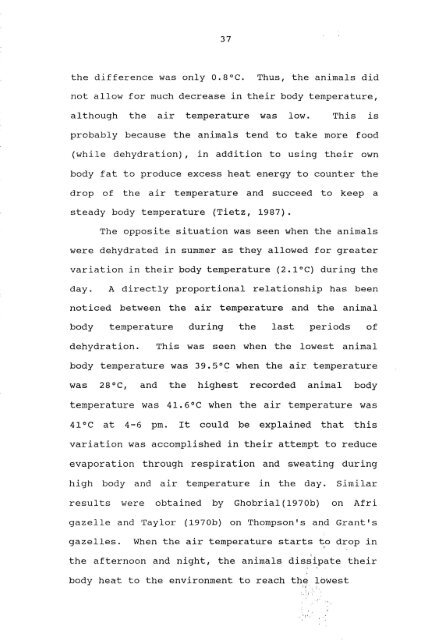Temperature and water deprivation and their effect on ... - Nwrc.gov.sa
Temperature and water deprivation and their effect on ... - Nwrc.gov.sa
Temperature and water deprivation and their effect on ... - Nwrc.gov.sa
- No tags were found...
You also want an ePaper? Increase the reach of your titles
YUMPU automatically turns print PDFs into web optimized ePapers that Google loves.
37 the difference was <strong>on</strong>ly O.8°C.Thus, the animals didnot allow for much decrease in <str<strong>on</strong>g>their</str<strong>on</strong>g> body temperature,although the air temperature was low. This isprobably because the animals tend to take more food(while dehydrati<strong>on</strong>), in additi<strong>on</strong> to using <str<strong>on</strong>g>their</str<strong>on</strong>g> ownbody fat to produce excess heat energy to counter thedrop of the air temperature <str<strong>on</strong>g>and</str<strong>on</strong>g> succeed to keep asteady body temperature (Tietz, 1987).The opposite situati<strong>on</strong> was seen when the animalswere dehydrated in summer as they allowed for greatervariati<strong>on</strong> in <str<strong>on</strong>g>their</str<strong>on</strong>g> body temperature (2.1°C) during theday.A directly proporti<strong>on</strong>al relati<strong>on</strong>ship has beennoticed between the air temperature <str<strong>on</strong>g>and</str<strong>on</strong>g> the animalbody temperature during the last periods ofdehydrati<strong>on</strong>.This was seen when the lowest animalbody temperature was 39.5°C when the air. temperaturewas 28°C, <str<strong>on</strong>g>and</str<strong>on</strong>g> the highest recorded animal bodytemperature was 41.6°C when the air temperature was41°C at 4-6 pm. It could be explained that thisvariati<strong>on</strong> was accomplished in <str<strong>on</strong>g>their</str<strong>on</strong>g> attempt to reduceevaporati<strong>on</strong> through respirati<strong>on</strong> <str<strong>on</strong>g>and</str<strong>on</strong>g> sweating duringhigh body <str<strong>on</strong>g>and</str<strong>on</strong>g> air temperature in the day. Similarresults were obtained by Ghobrial(1970b) <strong>on</strong> Afrigazelle <str<strong>on</strong>g>and</str<strong>on</strong>g> Taylor (1970b) <strong>on</strong> Thomps<strong>on</strong>'s <str<strong>on</strong>g>and</str<strong>on</strong>g> Grant'sgazelles. When the air temperature starts to drop inIthe afterno<strong>on</strong> <str<strong>on</strong>g>and</str<strong>on</strong>g> night, the animals dissipate <str<strong>on</strong>g>their</str<strong>on</strong>g>body heat to the envir<strong>on</strong>ment to reach the lbwest~ : . i :' ."' t ;.,.• ' ~ j •
















